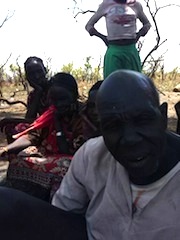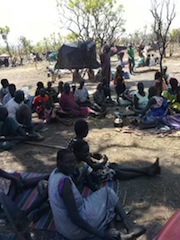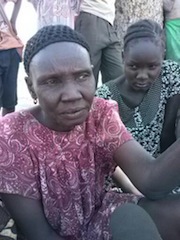FEATURE: Displaced South Sudanese recall past experiences
February 15, 2014 (NIMULE) – An hour ride on a motorcycle from Nimule, a South Sudanese town bordering Uganda, is Melijo where around 2,000 people are sheltering under trees having been displaced by the two-month-old conflict in South Sudan.

Samuek Deng Awuol was displaced to Eastern Equatoria from his home in the Newsite area of Juba after he witnessed intense fighting between mutinying soldiers aligned to former Vice President Riek Machar and forces loyal to the government of President Salva Kiir, which began on December 15.
President Kiir accuses Machar and others of staging a coup, but this is denied by all the accused despite Machar, who is now leading a rebellion of forces consisting of defected soldiers and armed civilians.
At least 10,000 people have been killed according to some estimates, while 707,400 people are displaced inside South Sudan and at least 149,700 have fled to nearby countries. Uganda hosts about 70,000 people.
Eastern Equatoria, according to the United Nations Office for the Coordination of Humanitarian Affairs (UNOCHA), is currently home to 59,200 people, most of whom are from Jonglei state. The region, which lies to the north of the capital, Juba, has seen some of the worst fighting since the mid-December outbreak of violence.
Those displaced in Melijo are just a handful of 35,000 people registered in Nimule district, according to South Sudan Relief and Rehabilitation Commission (SSRRC).
International and local aid agencies started distributing food and utensils to IDPs in Nimule in late January. When schools re-opened for students on February 3, the displaced who had sheltered in classrooms said they were left with no option, but look for nearby land to stay in.
Awuol, who is in his 70s, said the government has to help displaced people like himself start a new life.
“We are strong people. We could help the government if we are given food and medicines. We shall build [a] school for our children here,” Awuol told Sudan Tribune in Melijo on Friday.

South Sudanese rebels – who now form the ruling party (SPLM) and a large section of the national army (SPLA) – fought the Khartoum government for over two decades until a 2005 peace deal led to independence in 2011.
The current conflict was triggered by a dispute between the SPLM leaders over the party’s future and an internal power struggle for the chairmanship between President Kiir and three other senior figures including Machar, who was sacked as Vice President in July along with many of those who are now opposing the government.
Eastern Equatoria’s government does not want the displaced people to settle in the Nimule area, according to the state information minister Clement Laku Chimchim.
Chimchim said “security concerns” prompted the state government to ask for the relocation of IDPs to Kapeota, some 200km east of Nimule.
The IDPs in Melijo, however, said they want the government to focus on urgent needs of the vulnerable people.
Awuol, describes himself as a “serial displaced person” from the 1980s through to 2005 both from the SPLA’s conflict with Khartoum and the various conflicts between South Sudanese armed groups that characterised the civil war.
Many of the fault lines from the infamous split in the SPLA led by Machar in 1991 have been revisited in the current fighting on political, ethnic and military allegiances, exposing the lack of national building and meaningful reconciliation since the SPLM came to power in 2005.
“People who are here did not want to go to Uganda. I was in Nimule since December but just wonder ‘what are we going to get in Uganda? Why should we leave our country?’ ” said Awuol, a view shared by the people sitting around him.
The displaced people said they moved from Nimule town to Melijo as they felt that their plight was going unnoticed by the UN and other aid agencies.

“We need clean water, health centre and education for the surviving children,” she added.
The events of the last two months have reminded many of the displaced about the experiences they were trying to forget about the trauma of the civil war.
Aruar said she witnessed “some people drown in the [White Nile] river, others were killed during the fighting” when she fled Bor in December at the peak of the conflict over Bor, the Jonglei’s capital
The conflict over Bor revived Aruar’s memories of what she witnessed in 1991 when Machar’s forces attacked Bor, killing as many as 2,000 Dinkas, according to Amnesty International.
Sitting in one makeshift shelter, is a young woman who gave birth to a baby girl a week ago. She named her daughter “Nyariing”. “Nya” is a Dinka word for a girl and “riing” means “fleeing,” she explained.
“I took her for immunization once, but I don’t know what will happen next time because there is no health center here,” she told Sudan Tribune, asking to remain anonymous to protect her child’s identity.
Another woman gave birth to twins under a tree in Nimule after she had fled to Melijo with her family.
“The rain is about to begin and if it rain then we shall suffer more,” said John, the woman’s husband, who requested Sudan Tribune to withhold his surname.
The fighting between anti-government forces and government troops is reviving memories of Sudanese civil war. The current conflict, which observers view as having an ethnic dimension, has in many cases seen members of South Sudan’s largest tribe, the Dinka of President Kiir against the Nuer to which Machar belongs killed.
However, tribe is not the only factor in the conflict, illustrated by the fact that many of Kiir’s political supporters are Nuer and many of those opposing Kiir’s rule are from his Dinka ethnic group.
Awuol, called on South Sudan’s leaders, who are currently negotiating in Ethiopia, to end the cycle of violence before more lives are lost.
“I fled to Lobone [in Eeastern Equatoria] during the first fighting of Riek [Machar in 1991] and I am now here again in Rieks’ second spilt,” said Awuol, who is a Dinka.
The SPLM government and rebels calling themselves the SPLM-in-Opposition, signed a fragile ceasefire agreement on January 23, which has been violated by both sides over the last few weeks.
The second round of talks resumed this week in Addis Ababa under regional mediators. Machar’s delegation – and the third bloc formed from SPLM officials who were released from Juba last month having been detained over allegations that they were behind December’s alleged coup attempt – insist that the four remaining detainees be released and the Uganda forces who have fought alongside the SPLA withdraw from the country.
So far Juba has refused both demands but Sudan Tribune understands that the government’s chief negotiator has returned the South Sudanese capital for consultations with President Kiir.
The talks, with have been relocated to a resort outside Addis Ababa, are also expected to focus on the root causes of the conflict that, in the medium term, can be traced back to Kiir’s sacking of his entire cabinet July 2013 and the subsequent increased opposition to his rule from disaffected senior officials.
(ST)
